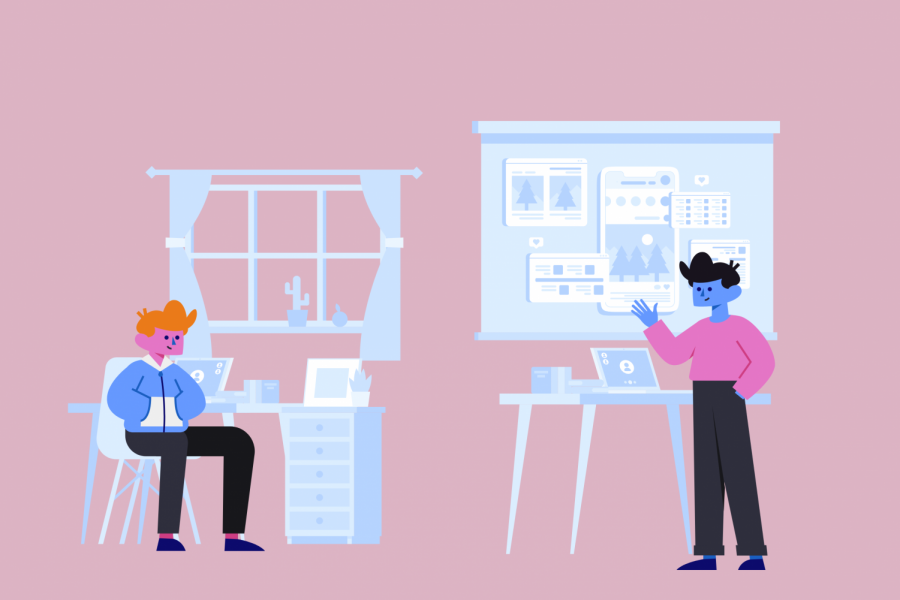Virtual learning shouldn’t mean the end of collaborative learning
Just because students learn virtually, doesn’t mean they must learn without collaboration.
October 18, 2020
We’ve all been there. The painful silence of a Zoom breakout room where no one turns on their camera or microphone, leaving the room full of blank screens and awkwardness. This has been all too common throughout the first month of school. While school may be entirely online for the foreseeable future, that shouldn’t mean the end of collaborative learning.
Collaborative learning is a teaching method that better allows students to engage with their peers by encouraging students to bounce ideas off each other, build bonds between classmates and assist one another in understanding class content. It is how we not only learn from textbooks and lectures, but from each other, too.
Though collaborative learning is certainly more difficult online than in person, it is not impossible. Whitman educators have already started to weave in collaborative exercises in class: many teachers use breakout groups to facilitate group discussions and some have started to implement collaborative assessment methods like group tests and projects.
This is a noble first step, but teachers aren’t doing enough. In order to maximize the success of students online, teachers should use group learning methods more frequently. Breakout rooms should be more structured, and students should be encouraged to play a more active role in their own learning process. It’s possible to ensure the best quality learning in these unideal situations, but everyone must put in the hard work to achieve it.
More group learning.
Virtual learning has created an opportunity for teachers and administrators to advance a long overdue change: a shift away from memorization-based tests in favor of assessments that enable students to apply learned material. Group projects and group tests ensure that students don’t just regurgitate information, but comprehend and apply material with their peers. In this less conventional style of learning, students bounce ideas off each other and come up with elaborative, creative responses.
“Group tests are really helpful,” sophomore William Hallward-Driemeier said. “It’s less about getting the right answer and more about the process, collaboration and being more creative.”
Group learning also maximizes academic integrity by removing the incentive and ability to cheat; Google cannot give you a detailed, unplagiarized answer to an essay or a project. On the other hand, administering more traditional forms of testing online makes it almost impossible to ensure academic integrity. No educator can tell for certain whether a student learned content, or just cheated with the help of the internet.
“Test security is very hard to maintain online,” said English teacher Matthew Bruneel. “We cannot rely on that as much anymore because there is no way to guarantee that a student isn’t getting academic help.”
Projects and group tests create the best of both worlds online; students learn material better, and teachers minimize cheating.
More structured breakout groups
Breakout rooms are one of the few tools that help teachers ensure that students interact with each other. In these first entirely virtual marking periods, breakout rooms seem to be the best way to recreate a classroom environment in an online setting. However, they aren’t being used to their full potential. In breakout rooms, it’s common for students to not participate or for conversations to taper off after quickly addressing the topic in question.
“Teachers need to make sure that kids feel comfortable with their classmates,” Hallward-Driemeier said. “There are plenty of instances of awkward silence in breakout rooms.”
Though some reluctance to participate in discussions is unavoidable, there are ways in which teachers can maximize the amount of student connection within breakout rooms. Educators should place a heavier emphasis on structured conversations and provide specific questions, which would prompt more discussion. Students perform better when they are directly told what to discuss; otherwise, they will opt to spend time on their phones for the rest of the class.
Breakout room designations are almost always chosen randomly, and being put into a group with strangers may be a source of discomfort. To combat this, teachers should allow students to pick their own groups more often, enabling them to work with the same familiar group of peers. For many students, getting to choose who they work with on a project increases their ability to effectively collaborate. Working with a self-selected group, rather than a pre-assigned one, would make group communication less awkward.
More active role from students
It is not enough for just the teachers to promote collaborative learning. For these techniques to be effective, we the students must take it upon ourselves to actively participate with our classmates. Human interaction is the primary part of the classroom environment that has been missing in these first few weeks of school.
These steps are easy to take. Instead of staring at our phones, we should keep our devices to the side or in another room. Turning our cameras on and leaving ourselves unmuted in breakout rooms simulates an in-person classroom, making it much easier for all of us to connect and learn. It is difficult to hold a conversation or gauge the reaction of a peer behind a screen, and that becomes even harder when countless students are muted and hidden behind a grey graphic with only their name visible. Students who feel comfortable participating online should also take an active role in conversations, which in turn would encourage our shier peers to speak up as well.
“I hope students will not be afraid to ask directly for another student’s input,” Bruneel said.
Making online learning better will help prepare us for a future that will likely shift more facets of life online. We don’t know what the rest of the school year will look like, but we should try to make the most out of our experience online.










